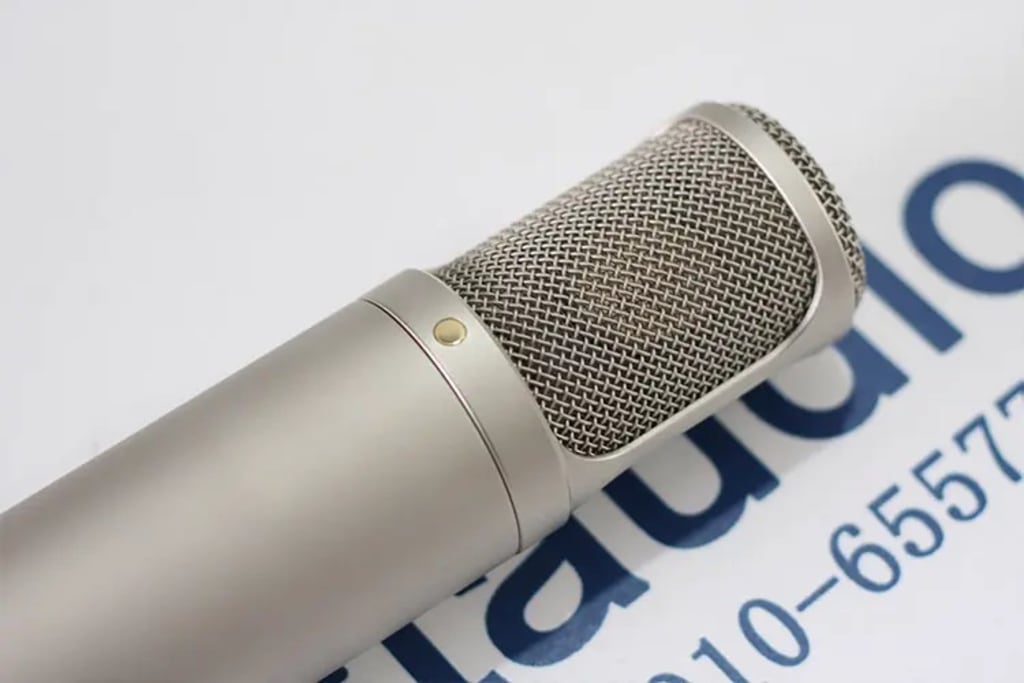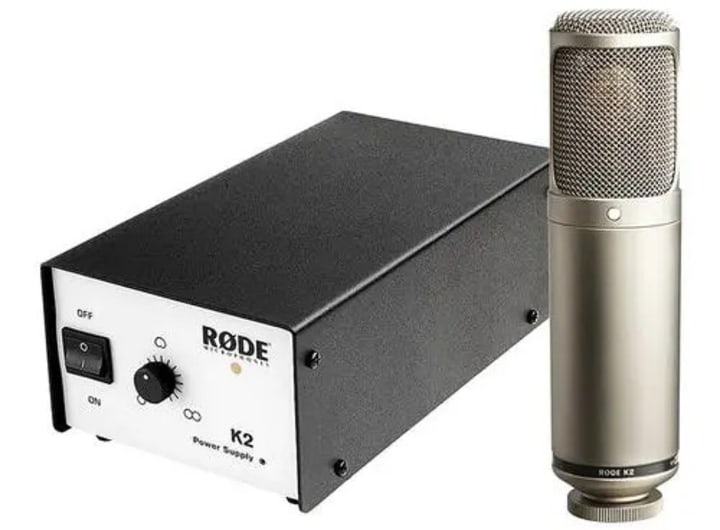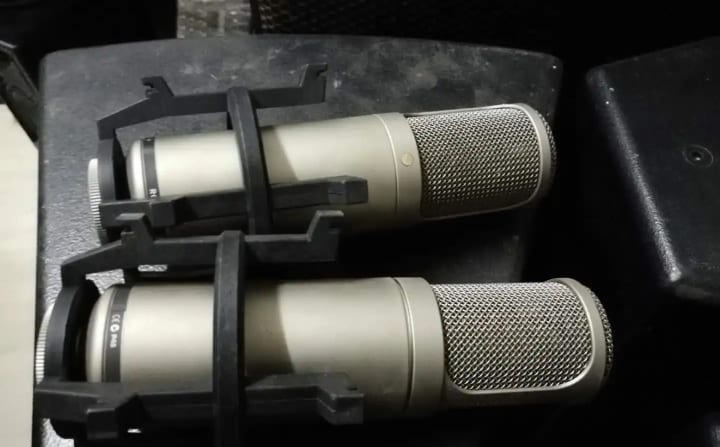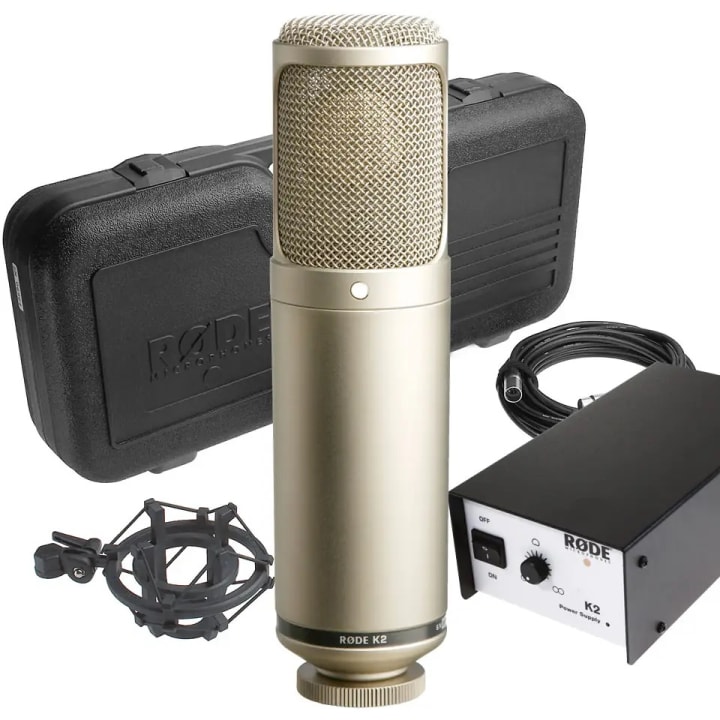Vioce Of An Angel-Rode K2 Microphone Review
RODE K2 MICROPHONE REVIEW

Why is a good microphone so important for recording? If you sit in a quiet room and close your eyes for a while, you will hear many environmental sounds that you may not have noticed before. The microphone will pick up a lot of sound that you never notice, so make sure that the microphone is recording the sound you want, without ambient noise and background noise.
A high-quality tube microphone is a better way to achieve this, while the cheap ones will only make the sound dirtier, and once you increase the gain, the problem of background noise will immediately come to the fore. So, let's take a look at K2, the tube microphone from Rode designed to improve the quality of home recording.

The microphone box is very large, and when you open it, the Rode K2 and its various components and accessories are placed there in good order. The K2 comes standard with a low-noise signal cable with a seven-pin (instead of a three-pin) connector for high-quality transmission of all audio signals and power between the K2 and the power supply. K2 has an all-metal shell, which looks very strong and heavy in the hand. This is great, considering that many tube microphones looked very fragile before, and the K2 looks like it won't leave a mark even if it gets hit by a truck. The power box (needed for all tube microphones to power the amplifier circuit) also has a control knob to adjust the directivity. Finally, don't forget to include an SM2 shockproof bracket as standard.

Main functions of Rode K2:
The beautiful gold metal casing of K2 is made locally in Australia. Rode's metal processing plant is located just north of Sydney, 250 kilometers away, where newer computer-controlled machinery is responsible for the production of all series products.
One thing that stands out about Rode is how they achieve the desired product results. Rode has produced thousands of tube microphones, and their testing capabilities are stronger and more rigorous than those of other companies or design groups. Rode-designed tube microphones were tested on the rare Tektronix 570 platform, which Rode has benefited from since the 1950s. Its benefit is that it enables Rode to test the performance of the circuit under extreme conditions, ensuring that every part of the product reaches the expected level and high-quality sound, so that users can get the product they expect.
Complete multidirectional design
In this way, a microphone positioned for high quality may not have only a single directivity. With flexible directional settings, you can easily tell the microphone which direction to pick up the sound. The following diagram will give you an idea of three common pointing characteristics.
Cardioid pointing is the easiest to control, as he will only record the sound of the front of the microphone, which is convenient for acoustic guitar recordings, violin or vocal recordings.
Figure 8 picks up both the front and back of the microphone, but not the left and right sides, which comes in handy when recording multiplayer background harmonies. Omnidirectional can pick up sound from all directions of the microphone, and it can record more ambient sound in comparison.
Note that these are just typical settings that are commonly used. Rode wanted more settings, and they did. K2 not only allows the user to use these typical settings, but also allows you to set them somewhere in the middle of the two orientations. This gives you enough freedom to adapt the microphone to your particular recording requirements or to a particular instrument.

Unbelievable low noise
10dBA! That means it's very quiet. ? Will not introduce any unwanted noise to your recording. In addition, you can also use the shock mount, so that you will not pick up the vibration noise caused by the microphone rack.
Test
Now let's move on to the testing phase. Testing for Rode K2 took place at the 12am recording studio in Melbourne, Australia, which featured a variety of instruments (violin, trumpet, voice, etc.). The K2 sits on a standard microphone stand with a windshield on the front. The power supply box is wired to my mixing console (Mackie 24/8), then into a Motu sound card and a dual-processor G4 computer, and the recording sequencer uses Emagic Logic Platinum.
The violins and trumpets were the first to take part in the test, and of course the windscreen was useless at this time. When recording these instruments, the first thing that surprised me was the localization of the sound. The sound recorded in the heart-shaped direction was warm and rich, but once the directional knob was turned to the sides, the sound changed significantly. The omni-directional sound is wider and picks up more of the room ambient sound. This makes the recorded sound sound wider and deeper, which is impressive.
The K2 has a much wider frequency response than a dynamic microphone, so it picks up a wider spectrum of sound. This is important because the microphone is at the front of the long audio signal transmission and processing chain, and the wider the frequency response, the more room there is for post-production.
The Rode K2 vocal recording test was then conducted. A tube microphone is usually preferred for studio vocal recording because it makes the sound warmer. There is no doubt that even a non-professional ear can easily distinguish the sound of a tube microphone from a dynamic microphone. We've been recording a lot of vocals for broadcast and demo CDs in the past, and at that time we often used some vocal processing tools, such as Antares. In the K2 test, its sound is not only clean and bright, but also very different when the directivity changes.

Who is this Mac made for?
K2 is a professional tube microphone, but the price is not high. In my opinion, who wouldn't want to add a microphone like this to their studio? K2 provides a satisfying platform that lets you record almost any sound, whether it's acoustic bass, drums, orchestration, or vocals. However, it is clear that such a mic is suitable for studio and studio recording, not for live performance. The K2 comes with a separate power supply box, so you don't need phantom power on the mixer or sound card anymore.
Sum up:Now there is another great option on the market, and for owners of small recording studios, there is no need to spend a lot of money to upgrade the sound quality of the recording studio. If you're looking for a tube condenser microphone, the K2 is the right choice for sound, low noise, price and standard equipment. You can compare the performance and price with other high quality microphones such as Neumann, Blue or AKG. These manufacturers all make great microphones, but at the same price, no other microphone has such a wide range of adaptability to instruments, which is really good value for money. Whether it's a large studio or a small studio, the K2 may be a better choice than those tube microphones that are ten times more expensive.
About the Creator
Bruce Huang
I am an avid fan of filmmaking and vlogging, and share vlog works and vlogging knowledge.





Comments
There are no comments for this story
Be the first to respond and start the conversation.